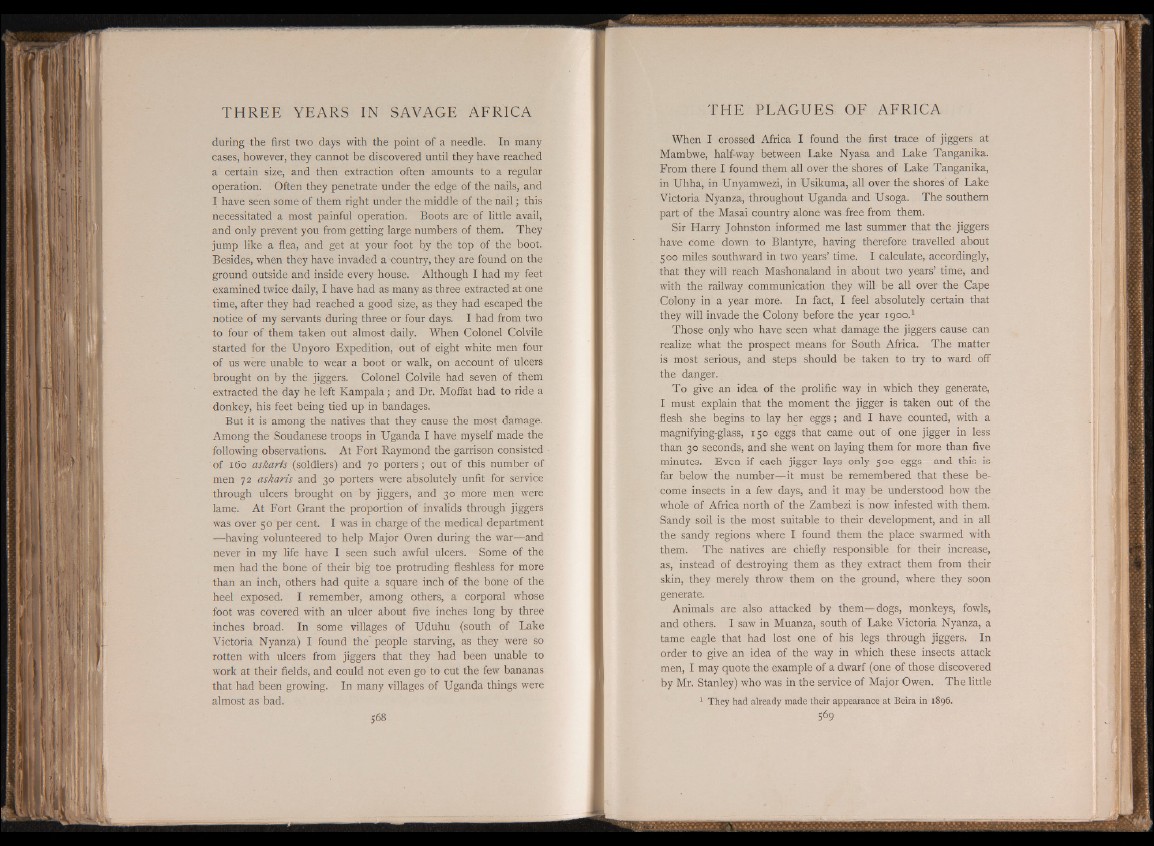
during the first two days with the point o f a needle. In many
cases, however, they cannot be discovered until they have reached
a certain size, and then extraction often amounts to a regular
operation. Often they penetrate under the edge o f the nails, and
I have seen some o f them right under the middle o f the n a il; this
necessitated a most painful operation. Boots are o f little avail,
and only prevent you from getting large numbers of them. They
jump like a flea, and get at your foot by the top o f the boot.
Besides, when they have invaded a -country, they are found on the
ground outside and inside every house. Although I had my feet
examined twice daily, I have had as many as three extracted at one
time, after they had reached a good size, as they had escaped the
notice o f my servants during three or four days. I had from two
to four o f them taken out almost daily. When Colonel Colvile
started for the Unyoro Expedition, out o f eight white men four
of us were unable to wear a boot or walk, on account o f ulcers
brought on by the jiggers. Colonel Colvile had seven o f them
extracted the day he left K am p a la ; and Dr. Moffat had to ride a
donkey, his feet being tied up in bandages.
But it is among the natives that they cause the most damage.
Among the Soudanese troops in Uganda I have myself made the
following observations. A t Fort Raymond the garrison consisted
of 1 60 askaris (soldiers) and 70 p orters; out o f this number of
men 72 askaris and 30 porters were absolutely unfit for service
through ulcers brought on by jiggers, and 30 more men were
lame. A t Fort Grant the proportion o f invalids through jiggers
was over 50 per cent. I was in charge o f the medical department
— having volunteered to help Major Owen during the war— and
never in my life have I seen such awful ulcers. Some o f the
men had the bone o f their big toe protruding fleshless for more
than an inch, others had quite a square inch o f the bone o f the
heel exposed. I remember, among others, a corporal whose
foot was covered with an ulcer about five inches long by three
inches broad. In some villages o f Uduhu (south o f Lake
Victoria Nyanza) I found the people starving, as they were so
rotten with ulcers from jiggers that they had been unable to
work at their fields, and could not even go to cut the few bananas
that had been growing. In many villages o f Uganda things were
almost as bad.
When I crossed Africa I found the first trace o f jiggers at
Mambwe, half-way between Lake Nyasa and L ake Tanganika.
From there I found them all over the shores o f L ak e Tanganika,
in Uhha, in Unyam wezi, in Usikuma, all over the shores o f L ak e
Victoria Nyanza, throughout Uganda and Usoga. T h e southern
part o f the Masai country alone was free from them.
Sir Harry Johnston informed me last summer that the jiggers
have Come down to Blantyre, having therefore travelled about
500 miles southward in two years’ time. I Calculate, accordingly,
that they will reach Mashonaland in about two years’ time, and
with the railway communication they will be all over the Cape
Colony in a year more. In fact, I feel absolutely certain that
they will invade the Colony before the year 19 0 0 .1
Those only who have seen what damage the jiggers cause can
realize what the prospect means for South Africa. T h e matter
is most serious, and steps should be taken to try to ward off
the danger.
T o give an idea of the prolific way in which they generate,
I must explain that the moment the jigger is taken out o f the
flesh she begins to lay her e g g s ; and I have counted, with a
magnifying-glass, 15 0 eggs that came out o f one jigger in less
than 30 seconds, and she went on laying them for more than five
minutes. E v en if each jigger lays only 500 eggs— and this is-
far below the number—it must be remembered that these become
insects in a few days, and it may be understood how the
whole o f Africa north o f the Zambezi is now infested with them.
Sandy soil is the most suitable to their development, and in all
the sandy regions where I found them the place swarmed with
them. T h e natives are chiefly responsible for their increase,
as, instead of destroying them as they extract them from their
skin, they merely throw them on the ground, where they soon
generate.
Animals are also attacked by them—dogs, monkeys, fowls,
and others. I saw in Muanza, south o f L a k e Victoria Nyanza, a
tame eagle that had lost one o f his legs through jiggers. In
order to give an idea of the way in which these insects attack
men, I may quote the example o f a dwarf (one o f those discovered
by Mr. Stanley) who was in the service o f Major Owen. T h e little
1 They had already made their appearance at Beira in 1896.
569